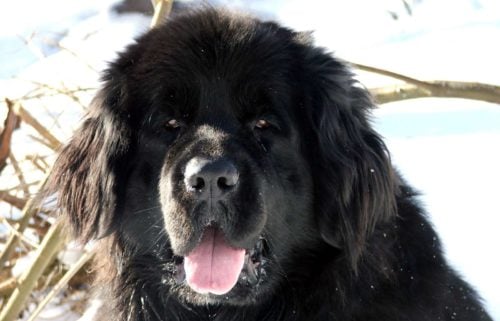Is your dog having her period? As owners of a female dog, we know how important it is to recognize the symptoms of heat. Our dog is spayed now, but when she was a puppy, she was a Newfie of breeding quality. She came from champion parents and spaying her was a decision we carefully decided against. She was almost 11 months of age and as her first heat drew near, we carefully observed her not to miss the first signs of estrus.
In this article, you’ll learn the long list of symptoms of a female dog in heat. Depending on the different heat stages, we have divided these into early signs and signs of the second phase of the heat.

Table of Contents
- Do dogs have periods?
- Early symptoms of the heat
- Symptoms of heat during the second phase
- Summary
- FAQ
Do dogs have periods?
Yes. The dog heat cycle is different from the human reproductive cycle however. For example, when a human female is going through her menstrual cycle, she will experience a bloody discharge which is her uterus shedding its lining. This human period symptom means she is no longer ready to get pregnant. The vaginal discharge is usually the first sign that she didn’t get pregnant. Dogs estrous cycle is different. Your dog may experience a bloody discharge during the estrus stage. This is the stage where is is getting ready to get pregnant. The vaginal discharge is an indication that her uterus is preparing to be receptive to support puppy development.

Early symptoms of the heat
The first phase of the dog heat cycle is proestrus. Its name suggests that it’s something that happens before the “real” heat. However, this stage of the estrous cycle is very real. Your dog will experience an increase in estrogen levels (read all about how hormones affect your dog in our article Do dogs have estrogen?). Starting with the first day of your dog’s estrous cycle, you’ll want to pay extra attention to your dog. Find 11 tips to handle a female dog in the heat here. The list of estrogen’s functions is quite long; you can read more on Wikipedia- Estrogen.
The first symptoms of a female dog in heat are as follows:
- Red discharge from the vulva. This is often called spotting or incorrectly, bleeding. During the first phase of your dogs estrus cycle, the lining of the uterus becomes softer which causes red discharge. Sometimes it may be apparent and you will see small spots on the floor. However if your dog cleans herself diligently, you may not notice drops on the floor. If you suspect she’s in her regular cycle, wipe your dog’s vulva with a white napkin or toilet paper. If you see red, pink, or sometimes yellow, you can confirm that your dog’s heat cycle has begun. NOTE: Discharge from the vulva can also be a sign of a medical condition such as an infection. Please visit your veterinarian if unsure.
- Behavior changes. Most dogs become restless during the heat. Please read our article on how to calm a female dog in heat. However, it’s common that a dog becomes less active or lethargic. Many dogs in heat will tend to become more aggressive towards other dogs and people during this time. Males may try to mate with her. At this stage, she may not be receptive to their advances.
- Affection adverse. Your female fur baby may normally love cuddles and her tummy rubbed. During this time, she may not like being touched or petted. Don’t take this personally, she is likely very uncomfortable and isn’t her normal loving, cuddle loving self.
- Enlargement of the vulva. In the early days of the heat cycle, cells of the uterus of your dog will enlarge. However, it’s not easy to notice. This is especially true if you don’t know what it looked like before. Shorthair dog owners may be more likely to see this change where our Newf’s long black hair hid this from us.
- Excessive licking. Your female in heat will likely lick her genital area more often than usual to clean all the reddish discharge. As pet owners, this is something you will likely notice before any blood-tinged discharge on the floor. This is normal behavior.
- Appetite changes. Dogs in heat can show both an increased or decreased appetite during the heat. On one hand, your dog needs more energy, but on the other, her mind may be focused on things other than food.
- Temperature increase. You can measure your dog’s temperature at home to check in the absence of the above obvious signs or behavioral signs. Note that the normal temperature range for dogs is between 101 and 102.5 Fahrenheit. Depending on the device you use, you may get a slightly different reading. As long as you use the same one consistently, you’ll be able to tell when her temperature has changed.
Symptoms of heat during the second phase
Now it becomes more exciting. Typically, about nine days after the heat began (read more about the length of each stage of the heat in our article Why do female dogs go into heat), your dog will enter the standing heat. It’s called standing heat because she will remain standing when a male mounts her. This is the Estrus stage. This is something that is referred to as the “real heat” when the symptoms of your dog will intensify. She will experience an increase in progesterone. This is the stage where your dog is able to get pregnant as this is her fertile period.
Here are common symptoms of the standing heat in dogs:
- Your dog will become willing to mate. During the first phase, your dog may be reserved, and even act aggressively towards male dogs. Now, she’ll become both more attractive to males and more attracted to male dogs herself. She’ll be very receptive and may even stick her rear in their face (ours did as the male stud wasn’t very experienced). Remember, this is her fertile time.
- Even more behavior changes. Was your dog restless during the first phase of the heat? Now she will go crazy. She will express her willingness to mate it through more activity, elevated reaction to small noises, and excessive vocalization. This includes whining, barking, and howling. Your dog may experience discomfort and pain similar to menstrual cramps in humans which is known as dysmenorrhea. She may also be more flatulent and have trouble sleeping. This is a very trying time for you the pet parent and your little girl. Trust us, it’s a very tough time for everyone. Going through this ourselves and working with many of our patients we put together our article: “Do dogs get period cramps? How to calm & soothe a dog in heat”. She is in search of a mate and keeping your dog in a fenced yard to keep her in and unwanted suitors away. A fenced-in yard helps but watch her carefully to avoid an unwanted pregnancy. Her reproductive cycle hormones are driving her behavior and she will do things she wouldn’t normally do, like jump the fence. Male dogs in the area can smell her from a very long distance. Don’t be surprised if you find male dogs in your backyard (we did).
- Tail wagging and changes in gait. Here’s a simple test to tell if your dog is in standing heat already. Scratch your dog’s lower back (just above the base of her tail) with your hand. If she pushes back and bends her tail to the side, this is a sign of standing the heat. Your dog may also swing her hips and wag her tail high up as she walks.
- Discharge changes color. As the standing heat approaches, previously red discharge from the vulva may become pink, yellow, or even unnoticeable. If you have her in doggie diapers, you may notice this when you change them.
- Vulva becomes softer. Swelling of her vulva will decline gradually. This may be subtle and not very noticable.
- Increased, frequent urination. Urine is a marker and tells other dogs that your dog is in heat. Therefore, your dog will dispense urine in smaller amounts over various locations. If you have to walk her, keep her on leash at all times. Avoid areas where you know intact males are to avoid an unwanted pregnancy. And no, doggie diapers will not prevent an unwanted pregnancy. Doggie diapers are not a contraceptive.
- Symptoms from the first phase of the heat continue. Symptoms of heat such as appetite changes and increased body temperature may remain during the second phase of the heat.
Summary
Usually the presence of a few of the symptoms above may be enough to let you know if your dog is indeed in heat. However, the only sure way to tell if your dog is in the heat is to run tests at a veterinary clinic. Your veterinarian can run a few simple tests to confirm if she’s in heat and determine the optimal time for breeding. This was critical when we bred our girl. It really helped reduce the stress on us, her, the male dog, and the males parents.
Please note: If the main reason you are looking up symptoms of female dogs in heat is to avoid an unwanted pregnancy, the symptoms above will give you enough information about times when you should be cautious (starting from the day you first notice signs). We strongly recommend spaying female dogs if you don’t want to plan for puppies. It also eliminates the chances she will develop mammary cancer.
You have learned the long list of symptoms of a female dog in heat. This will help you recognize how dogs in heat will behave. This will go a long way towards a healthy and happy life with your pet dog. And keeping your Pet Happy is what we all want.
Is your dog in heat? Identifying the symptoms that your dog is in heat is only one of the things you should be aware of. Take a look at our series: Dog Heat Cycle: A Comprehensive Guide for Pet Owners for more tips and information.
FAQ
Question: Do dogs have periods?
Answer: Yes, but it is called the estrus cycle in dogs.
Question: What is the difference between the human menstrual cycle and the dog heat cycle?
Answer: In the human menstrual cycle, the uterus sheds its lining indicating that the female is no longer able to get pregnant. In the dog’s estrus cycle, a bloody discharge indicates that the dog is getting ready to get pregnant.
Question: What are the early symptoms of a female dog in heat?
Answer: Red discharge from the vulva, behavior changes, affection avoidance, enlargement of the vulva, excessive licking of the genitals, appetite changes, and a temperature increase.
Question: What is proestrus?
Answer: It’s the first phase of the dog heat cycle. It is the preparation for the fertile period of the cycle.
Question: What is standing heat?
Answer: It is the second phase of the dog heat cycle called the Estrus stage. This is when the female is fertile and willing to mate.
Question: How can I confirm if my female dog is in heat?
Answer: Check for physical and behavior changes. To know for sure, please consult with your veterinarian.
Next: When things don’t go as planned
Previous: How hormones regulate the heat cycle in dogs
